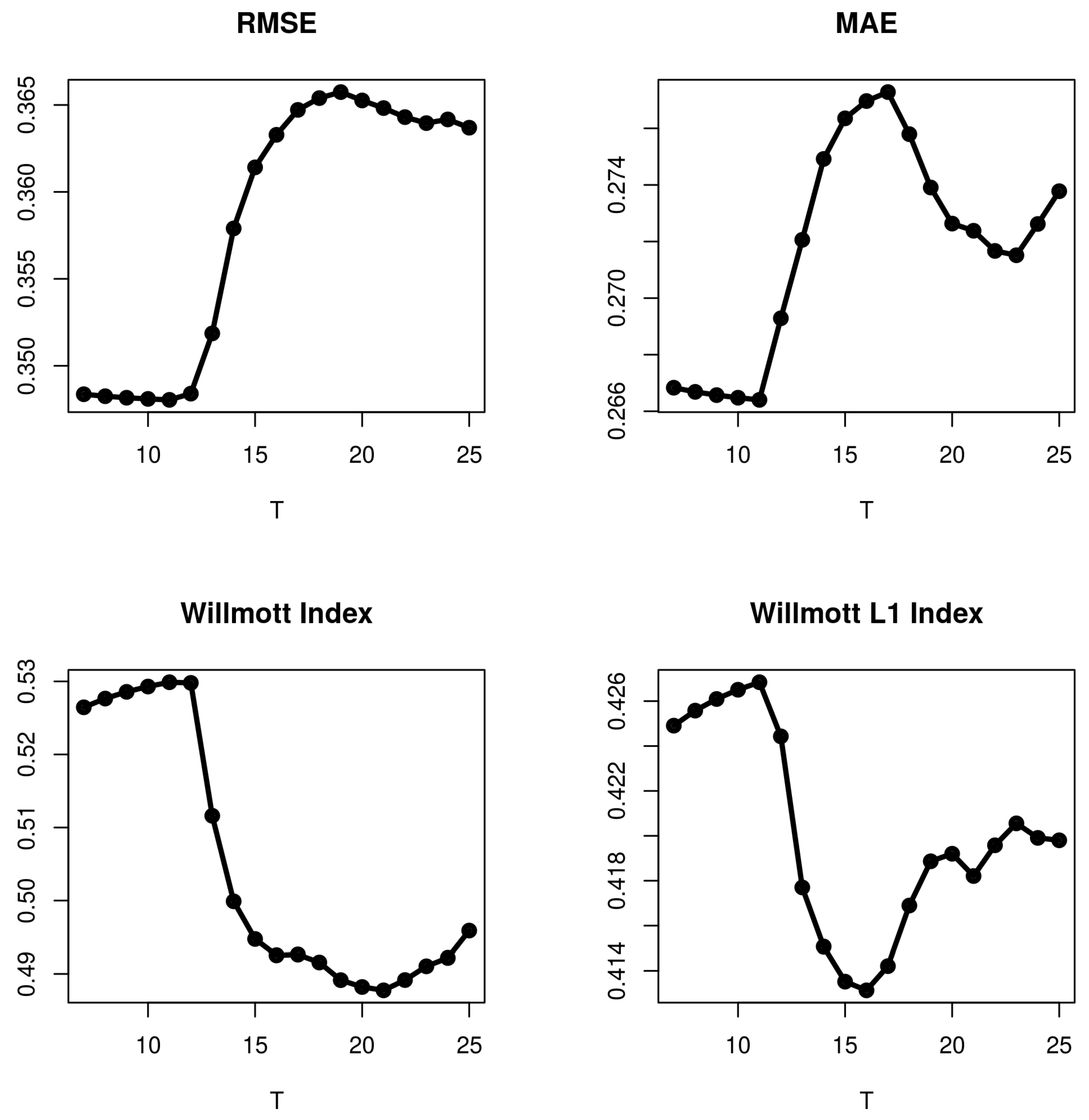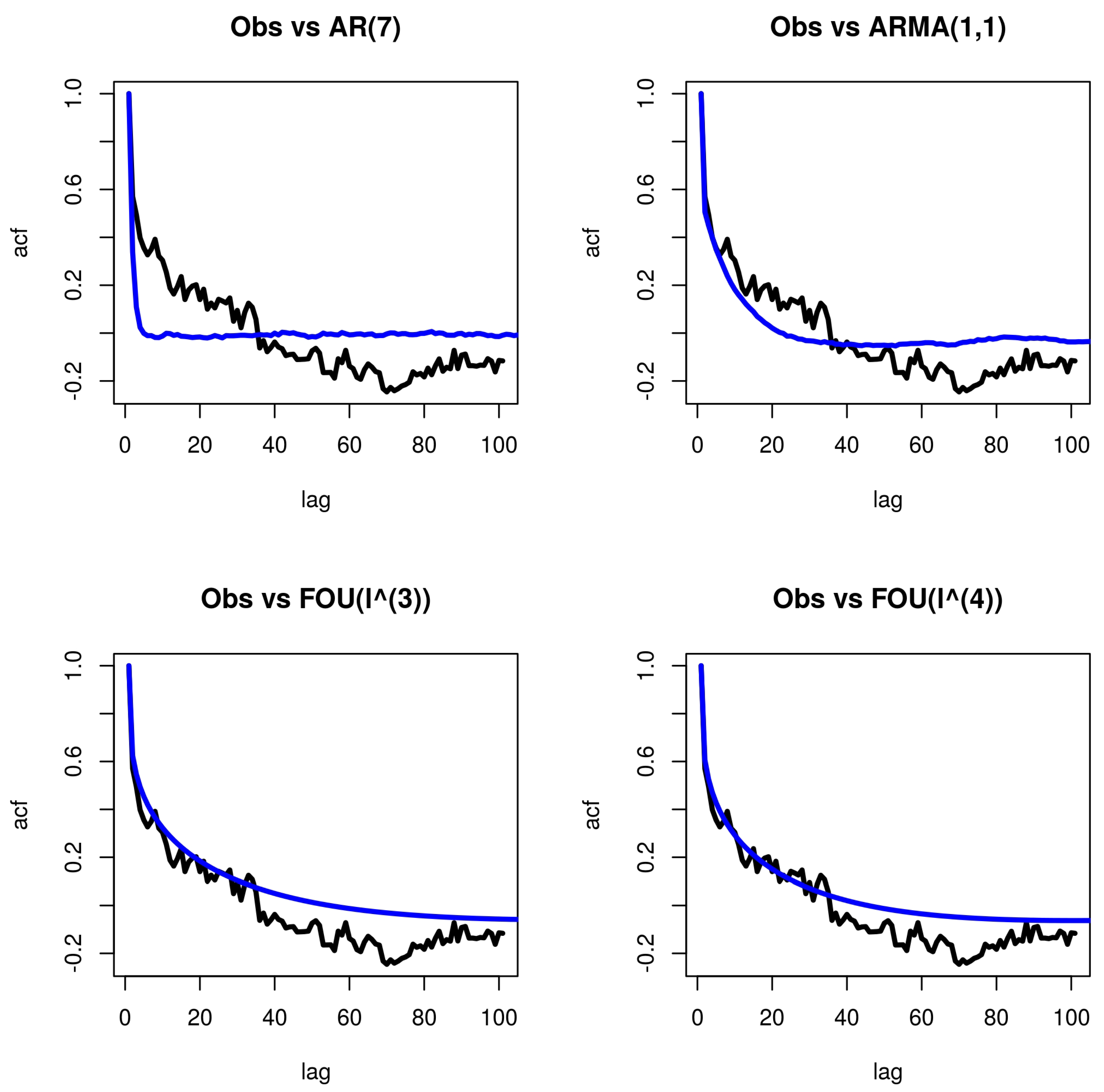Modelling a Continuous Time Series with FOU(p) Processes †
Abstract
:1. Introduction
2. Definition of FOU(p) Processes
3. Parameter Estimation
3.1. Estimation of H and
- for all
3.2. Estimation of the Parameters
4. Modelling an Observed Time Series Using FOU Processes
4.1. Choosing the Value of T
4.2. An Application to Real Data
5. Some Concluding Remarks
- 1.
- FOU processes are a Gaussian family of continuous-time stochastic processes that generalize (by taking ) the classical fractional Ornstein–Uhlenbeck processes.
- 2.
- When , any FOU has short-range dependence for every value of H, whereas for and , it is well known that the classical fractional Ornstein–Uhlenbeck process has a long-range dependence. In addition, any long-range dependence fractional Ornstein–Uhlenbeck process () can be approximate for some FOU (short-range dependence).
- 3.
- As p grows, the FOU process has a shorter memory (in the sense that the autocorrelation function goes more quickly to zero).
- 4.
- Under general conditions, it is possible to estimate all the parameters of any FOU process in a consistent way.
- 5.
- 6.
- Another possible advantage (that should be studied) of using a FOU process to model a continuous-time dataset (rather than a discrete-time model) is the Hölder index (H), since H gives a measure of the irregularity of the trajectories. Smaller values of H indicate more irregular trajectories.
Funding
Institutional Review Board Statement
Informed Consent Statement
Data Availability Statement
Conflicts of Interest
References
- Kalemkerian, J.; León, J.R. Fractional iterated Ornstein-Uhlenbeck Processes. ALEA 2019, 16, 1105–1124. [Google Scholar] [CrossRef]
- Ibragimov, I.A.; Rozanov, Y.A. Gaussian Random Processes; Springer: Berlin/Heidelberg, Germany, 1978. [Google Scholar]
- Istas, I.; Lang, G. Quadratic variations and estimation of the local Hölder index of a Gaussian process. Ann. L’inst. Henry Poincaré 1997, 23, 407–436. [Google Scholar] [CrossRef] [Green Version]
- Kalemkerian, J. Modelling and Parameter Estimation for Discretely Observed Fractional iterated Ornstein-Uhlenbeck Processes. arXiv 2020, arXiv:2004.10369. [Google Scholar]
- Cheridito, P.; Kawaguchi, H.; Maejima, M. Fractional Ornstein-Uhlenbeck Processes. Electron. J. Probab. 2003, 8, 1–14. [Google Scholar] [CrossRef]
- Kalemkerian, J. Parameter Estimation for the FOU(p) Processes with the same lambda. arXiv 2022, arXiv:2202.00642. [Google Scholar]
- Arratia, A.; Cabaña, A.; Cabaña, E. A construction of Continuous time ARMA models by iterations of Ornstein-Uhlenbeck process. SORT 2016, 40, 267–302. [Google Scholar]
- Brouste, A.; Iacus, S.M. Parameter estimation for the discretely observed fractional Ornstein-Uhlenbeck process and the Yuima R package. Comput. Stat. 2013, 28, 1529–1547. [Google Scholar] [CrossRef] [Green Version]
- Box, G.E.P.; Jenkins, G.M.; Reinsel, G.C. Time Series Analysis, Forecasting and Control; Prentice Hall: Hoboken, NJ, USA, 1994. [Google Scholar]
- Cleveland, W.S. The inverse autocorrelations of a time series and their applicattions. Technometrics 1971, 14, 277–298. [Google Scholar] [CrossRef]
- McLeod, A.I.; Zang, Y. Partial autocorrelation parametrization for subset autoregression. J. Time Ser. Anal. 2006, 27, 599–612. [Google Scholar] [CrossRef] [Green Version]


| Model | RMSE | MAE | ||
|---|---|---|---|---|
| AR(7) | 0.6184 | 0.4943 | 0.2995 | 0.2167 |
| ARMA(1, 1) | 0.5883 | 0.4620 | 0.3120 | 0.2343 |
| FOU | 0.6263 | 0.4743 | 0.3076 | 0.2372 |
| FOU | 0.6260 | 0.4743 | 0.3076 | 0.2371 |
| FOU | 0.6244 | 0.4733 | 0.3074 | 0.2369 |
| FOU | 0.6247 | 0.4712 | 0.3086 | 0.2393 |
| FOU | 0.6277 | 0.4750 | 0.3078 | 0.2373 |
| FOU | 0.6264 | 0.4742 | 0.3076 | 0.2372 |
Publisher’s Note: MDPI stays neutral with regard to jurisdictional claims in published maps and institutional affiliations. |
© 2022 by the author. Licensee MDPI, Basel, Switzerland. This article is an open access article distributed under the terms and conditions of the Creative Commons Attribution (CC BY) license (https://creativecommons.org/licenses/by/4.0/).
Share and Cite
Kalemkerian, J. Modelling a Continuous Time Series with FOU(p) Processes. Eng. Proc. 2022, 18, 33. https://doi.org/10.3390/engproc2022018033
Kalemkerian J. Modelling a Continuous Time Series with FOU(p) Processes. Engineering Proceedings. 2022; 18(1):33. https://doi.org/10.3390/engproc2022018033
Chicago/Turabian StyleKalemkerian, Juan. 2022. "Modelling a Continuous Time Series with FOU(p) Processes" Engineering Proceedings 18, no. 1: 33. https://doi.org/10.3390/engproc2022018033
APA StyleKalemkerian, J. (2022). Modelling a Continuous Time Series with FOU(p) Processes. Engineering Proceedings, 18(1), 33. https://doi.org/10.3390/engproc2022018033






